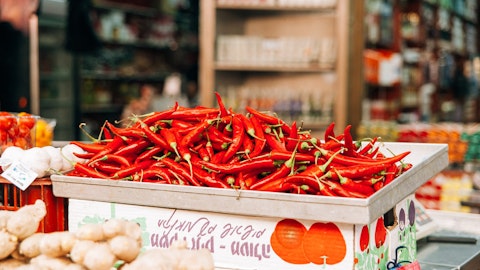And I would just point to our Boeing trends throughout ’23. And as we think about ’24 to be an indication of how we think we’re performing relative to the market there overall. And so those are some indications. Now, the other one on top of that would be heat. And we continue to see growth through heat. We continue to see that as a as the part of that portfolio, if you will, it tends to grow at an even higher rate just due to where consumers are. And we talked a lot about heat extensively in terms of how popular it is. And so that’s another reason to believe that we feel like we’re competitively poised in this part of our business. It’s an exciting part of our business. It’s an exciting part of our business. It’s one that’s receiving a lot of increased investment, too, as we think about building capacity, technology and really growing to global scale.
Adam Samuelson: Okay. I appreciate the color all. I will pass it on. Thanks.
Operator: Thank you. Our next question comes from the line of Matt Smith with Stifel. Please proceed with your questions.
Matt Smith: Hi. Good morning. Thank you for taking my question. I wanted to dive in a little bit on the guidance. If we look at it from a high level, it includes roughly 80 basis points or so of operating margin expansion. Can you talk about the expansions for each business as we look at fiscal 2024? Is Flavor Solutions expected to have an outsized contribution again as margin continues to recover there? And can the margin expand in the Consumer business, even as you step up investments to manage price gaps and absolute price points?
Mike Smith: Hi Matt, its Mike. I mean they’re not materially different between segments to be honest. So the 50 to 100 basis points at the gross margin line and approximately 80 at the OP margin line. To your point, there are some price gap management items within the Consumer business, but there’s also portfolio optimization, the GOE and CCI numbers which hit both segments. So I would say not materially different.
Matt Smith: Thank you for that. And a follow-up on the price gaps and absolute price points that you’re talking about managing. One thing we’re seeing in the U.S. measured channel data is that the share losses McCormick is seeing in spices and seasonings, only about 1/4 of that is going to private label. Can you talk about the branded environment? Are you seeing a pickup in competitive pressure there? Or is this really a product of price gaps that you believe you can manage to?
Brendan Foley: Largely, I think it’s a product of price gaps that we can manage to. But I think your observations would align with ours in that it isn’t strictly an issue regarding private label or other branded competition. I think it’s really an attractive category that has always received new competitors and new entrants. And so we look broadly when we think about competition in that part of our portfolio, as being — and at the shelf is both watching those gaps versus private label and also branded competitors.
Matt Smith: Thank you. I will pass it on.
Operator: Thank you. Our next question comes from the line of Robert Moskow with TD Cowen. Please proceed with your question.
Robert Moskow: Hi. Just a couple of follow-up questions hi there Brendan and Mike.
Brendan Foley: Good morning Rob. Hello.
Robert Moskow: Yes. In the past, you used to give a global flavor category growth rate, and I remember it being around 4% to 6%. Do you still keep track of that globally? And do you know where it is right now? And just — and then I have a follow-up.
Brendan Foley: We do. I mean we look at that annually. And it’s part of our strategic planning process. And so yes, we do spend time making sure we understand how that’s performing. But I think your 5% to 7%, I think, is — or actually you said 4% to 6%, but I would tell you it’s generally around those same numbers. We tend to think about it is 5% to 7% at a global level.
Robert Moskow: Okay. So the global demand for flavor really hasn’t changed. It’s just that — but your top line guide is around zero. So is the message here today that nothing’s really changed in the consumer demand for flavor? Because it sounds like you’re also saying there’s a lot of trading down going on or cautious consumer spending, so I thought that would mean that the category is a little bit weaker, too.
Brendan Foley: No, I would urge you not to take away that as an indication that the category is weaker. This is still a very attractive category. Also appreciate that the category at the global level has also gone through a lot of inflation in pricing and similar factors, but we still see this as a very attractive category for the total company. And so that is not the view that we take, particularly with the data that we look at. And so I think maybe that got at the heart of your question.
Robert Moskow: Yes, certainly. And then the follow-up is, you said that you shipped 75% of your new packaging to retailers so far. But do you have any way of quantifying what percent of the ACV has implemented your resets? I thought some of it would happen in 2023. It sounds like a lot will happen in mid-2024. But are you quantifying that way?
Brendan Foley: It’s harder to quantify because it’s – we know how much we’re shipping out in terms of our total portfolio that’s getting this new package. And so as I said, that number is at 75%. And that, we feel that’s – we’re pretty accurate about that. But now the reflection on shelf, as all this inventory is flowing in on shelf, that’s happening on a lag to that 75% number. We expect it to just continue to increase through the first half of the year. I think through the first half of the year, we should largely be caught up to that number to specific standpoint, too. If you walk into a store today, you’re going to see on the shelf some in the old package, some of the new package, and that’s just maybe an indication of how you might think about flow-through overall.





